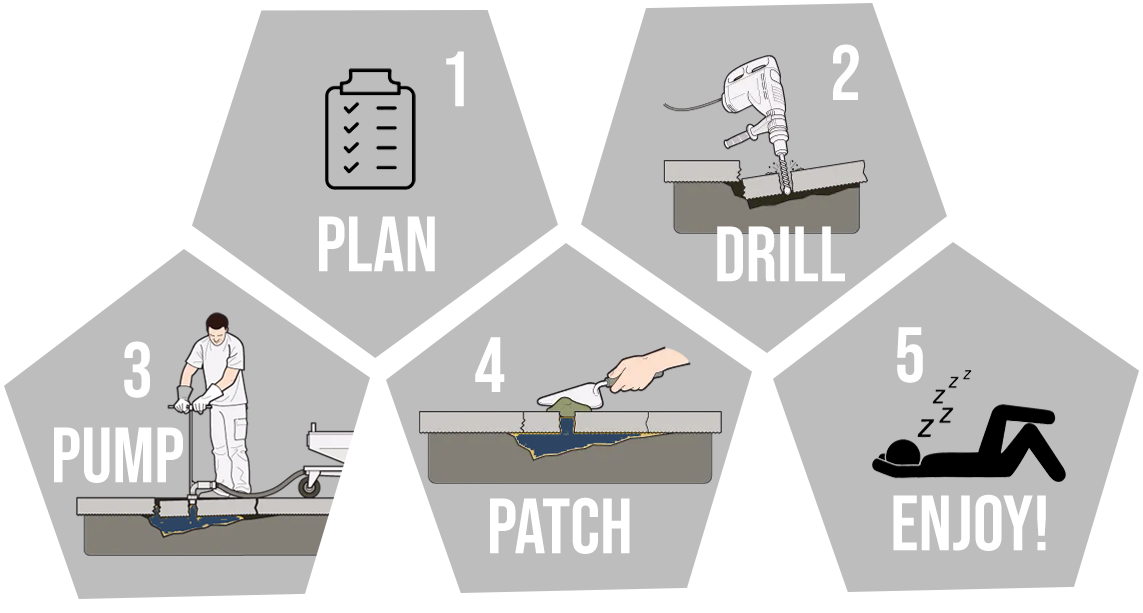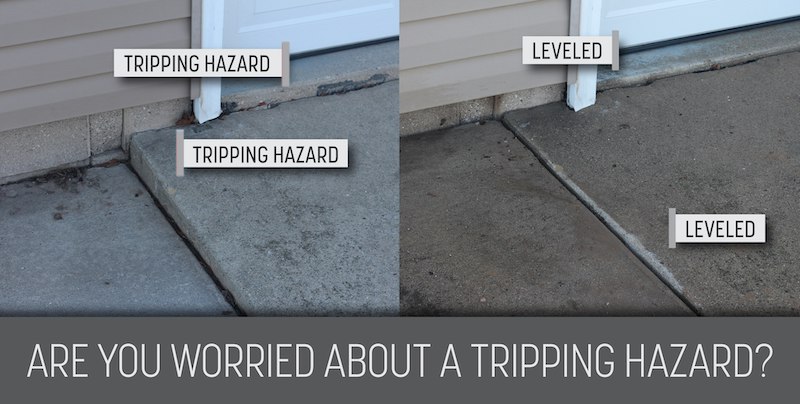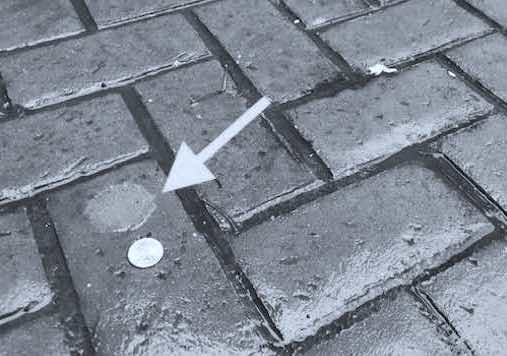Frequently Asked Mudjacking Questions
What exactly is concrete leveling?
Concrete leveling is a process used to raise and level uneven concrete surfaces. Basically we use a concrete-like material and pump it beneath the concrete to raise it. This technique levels sunken concrete. It is also referred to as concrete raising and concrete lifting, or slab jacking.
So what is mudjacking?
Mudjacking is a type of concrete leveling process for lifting concrete back to its original position. A mixture of limestone and clay is pumped into the voids beneath the concrete surface. This raises the concrete back to its original level and stabilizes it.
What causes concrete to crack or sink?
Concrete can sink or crack due to a variety of reasons, including poor soil compaction, water erosion, heavy loads, and tree roots. In most cases, it is simply natural settling over time. Uneven or sunken concrete can be a tripping hazard and can cause damage to vehicles driving over it. Here in Wisconsin, it’s quite common for concrete to sink.
What is your project minimum?
Our minimum job fee is $200.
Does my project come with a warranty?
Yes, all our mudjacking projects come with a 4-Year Satisfaction Guarantee that covers any settling or sinking issues.
What forms of payment do you accept?
We accept cash, check or Venmo.
How do I get started on my concrete raising project?
Contact Boost Concrete Raising for a free estimate. We will assess the condition of your concrete and provide you with an accurate quote and timeframe for completion. We look forward to working with you!
How long does mudjacking last?
Depending on when the concrete was originally poured, and how effective your drainage is, you can expect 4-8 years before you see some potential signs of settling again. In general, it is good maintenance practice to have your concrete inspected periodically.
How large are the holes?
We drill a series of holes to raise and support your concrete that are only about 1⅝ inch in diameter. We do all this with high pressure hydraulic pumps to fill in as many voids as possible under your concrete. Once the concrete is raised and supported, we fill the small holes drilled to match your concrete as closely as possible. Over time, the small holes will become barely noticeable.
What’s the difference between poly leveling and mudjacking?
Mudjacking and poly leveling are two techniques used for leveling uneven concrete surfaces. The main difference is in the material used. Poly leveling uses polyurethane foam to level and lift the concrete whereas mudjacking uses a cement slurry composed of clay and limestone. At Boost Concrete, we find mudjacking to be superior for many reasons… read on below…
What are the advantages of mudjacking?
 Some prefer one over the other, and at Boost Concrete Raising, we believe mudjacking is the superior concrete lifting technique for several reasons, including:
Some prefer one over the other, and at Boost Concrete Raising, we believe mudjacking is the superior concrete lifting technique for several reasons, including:
- Trusted technique: Mudjacking is tried and true, and has been the constant gold standard for almost 100 years
- Cost-effective: For most residential projects, budget is a priority, and mudjacking is much more friendly on your wallet. Using a high-density commercial grade polyurethane foam can cost up to four or five times that of a cement slurry.
- Less invasive: The hole size is only about an inch in diameter, and once the holes are filled, it is extremely hard to see them unless up close. Mudjacking requires small holes to be drilled into the concrete surface, minimizing disruption and damage to your property.
- Quick turnaround time: With minimal curing time, you can usually use the raised concrete within hours. This means less downtime for your daily routine or business operations.
- Environmentally friendly: Any concrete that has polyurethane attached to it may not be accepted at a toxic waste facility. According to the EPA, polyurethane has shown links to cancer in humans and animals and at Boost Concrete, we have chosen to avoid any possible harmful chemicals whenever possible.
- Versatile: Mudjacking can be used on various types of concrete surfaces such as driveways, patios, sidewalks, and more. It is also effective for both residential and commercial properties.
How much money will I save by choosing mudjacking over concrete replacement?
Mudjacking is the most cost-effective approach to fixing sunken, tilted, or uneven slabs of concrete. By raising instead of replacing you will spend approximately only ¼ of the cost compared to ripping out the concrete and starting from scratch. Plus, with minimal disruption to your daily routine or business operations, you will save time and money as well.
What types of concrete surfaces can be mudjacked?
Mudjacking can be used on almost any settled concrete including driveways, garages, patios, poolside slabs, etc. Our services are extensive and we can solve sinking concrete for almost any issue for business owners and homeowners.
 When can I use the area again?
When can I use the area again?
In most cases, you can use the area in just a few short hours.
Is this process environmentally friendly?
Yes. We use a mixture of naturally occurring materials such as a clay or limestone mix. No material is typically removed and disposed of in a landfill. We believe our techniques are a more sustainable and environmentally friendly option compared to ripping out and replacing concrete or using polyurethane in poly leveling.
What is considered a trip hazard? Do I need to worry about trip hazards?
Sidewalk trip hazards can become major legal liabilities, so it’s best to repair cracked concrete immediately. According to the Americans with Disabilities Act (ADA), prevalent trip hazards often arise from damaged or uneven sidewalks and driveways, particularly at joints or cracks. The ADA characterizes a trip hazard as any vertical displacement greater than 1/4 inch at any joint or crack.




